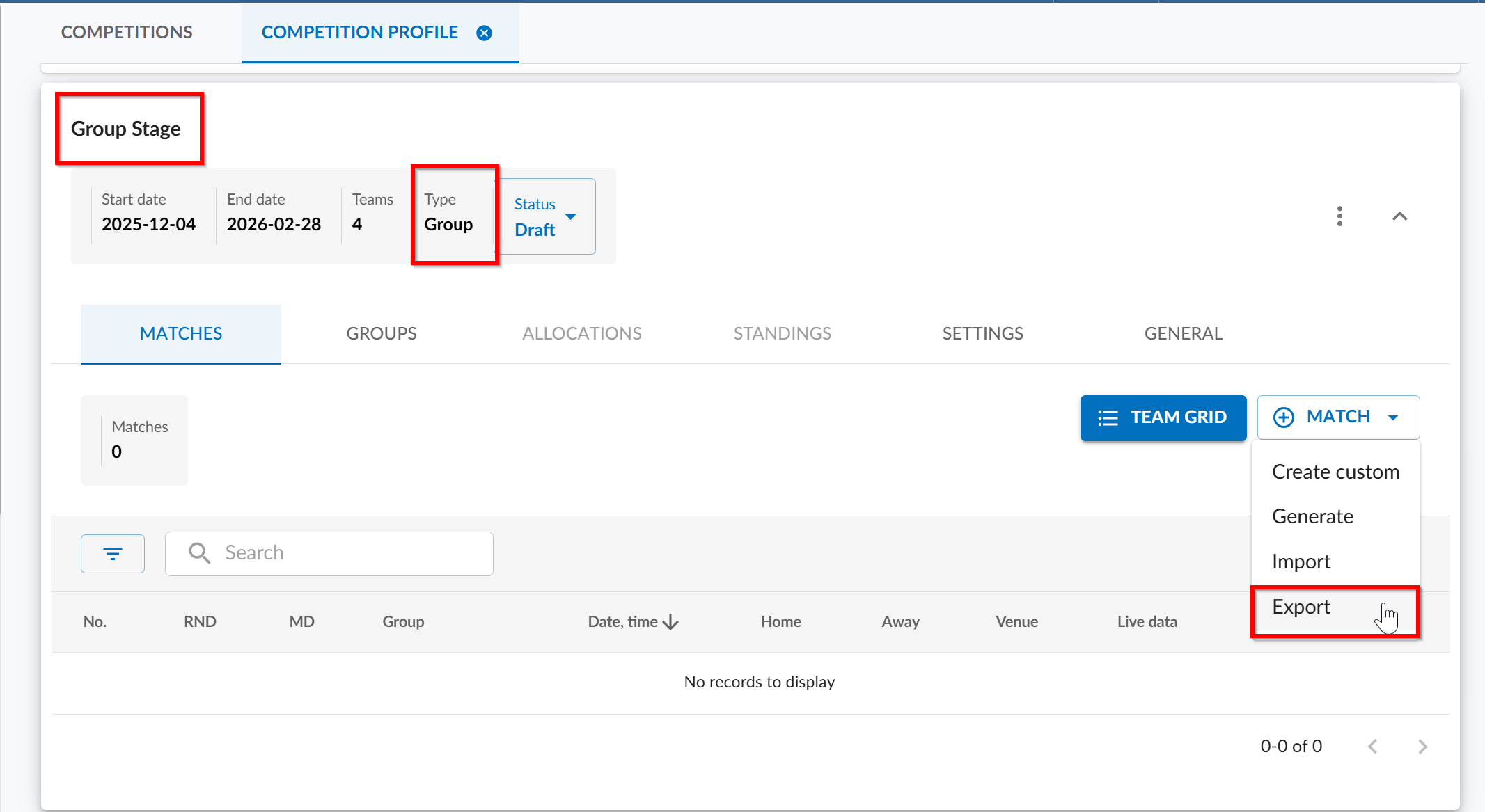This guide will show you how to use Football Competition Management System to import a fixture.
Step A: Set-up the Competition Step B: Prepare the Import File Step C: Perform the Import |
STEP A
1. Select Competition
After logging into the system, select Competitions on the left-hand side and go through the steps to create a competition.
User Guides on each Competition type can be found below:
Round Robin Competition - here
Group Stage Competition - here
Knock Out Competition - here
Ensure Stage Status remains set to 'Draft'. A Fixture Import is not able to be performed if the Stage Status is changed to 'Scheduled'.
2. Select Stage of Competition to Import
Select the stage where you want to import those fixtures, then select the "Matches" tab.
3. Populate Teams
Select on Team Grid and populate teams to specific slots, which will be used in a template.
STEP B
4. Download Fixture Import Template file
Once you have created the competition stage (Round Robin, Knockout, or Group Stage) and added the teams to the Team Grid as described in Step 3, you can download the corresponding fixture template by clicking the “+ Match” button and selecting “Export”.

You can find the stage‑specific template files attached at the bottom of this page.
You can also adjust a copy of an import file that you have successfully used before. Please be careful that Excel does not automatically change the date format when opening a .csv file. If you decide to reuse a previously imported file, make sure it corresponds to the same stage type you are importing into. For example, a template created for a Round Robin stage cannot be imported for a Group Stage.
5. Complete Fixture Import file
The Import file you use must be populated with data that complies with the following requirements:
- Match number: This should be a different number for each match, in sequence order for example 1, 2, 3, 4, 5 ...
- Round number: If teams play each other twice you would have only '1' and '2' in this column, example 1 for the first round and 2 for the second round
- Match Day number: If there are 18 Match Days/Weeks, you would list them 1 to 18
- Match date time: Format must be "yyyy-mm-dd hh:mm" (24 hour format)
- Home team: Is the name of the teams that have been added to the competition. Each team name must be spelled identically to the team names added to that competition.
- Away team: Is the name of the teams that have been added to the competition. Each team name must be spelled identically to the team names added to that competition.
- Home team slot number: Populated with a number matching the slot that the team was assigned to in the Team Grid (Step 3 above) [this can be left blank if the Team Names have been added]
- Away team slot number: Populated with a number matching the slot that the team was assigned to in the Team Grid (Step 3 above) [this can be left blank if the Team Names have been added]
- Venue: If including Venues as part of Import, the Venue Name must be spelled identically to what is listed in the Competition Management System
- Venue ID: This can be ignored as part of the import (this would be populated in this file if you had performed an 'Export' of a Competition with assigned Venues) [this can be left blank if the Venue Names have been added]
- Time zone: This can be added if matches are played in different time zones. Format must be "Region/City" e.g. Asia/Tokyo [this can be left blank if all matches are played in the competition default time zone]
- The Import file must be converted to CSV type file (using UTF-8 encoding) (from Excel 'Save As', then change 'File Format')
- The column headings must be in English (as contained in the attached examples)
Please ensure the completed file is saved as a CSV type file (using UTF-8 encoding).
If you have additional setting options when saving the file, ensure that the file delimiter is the comma ( , ) character.
Use the apostrophe before entering the date, for example '2021-09-30 15:00
Use a formulae that refers to the REAL date value, for example =Text(Cell reference,"yyyy-mm-dd hh:mm"), then copy paste values in the correct column
Highlight column D and force it to be a TEXT column before the dates are entered
STEP C
6. Import Fixture
Within the Competition select the Import button. Here you can select to upload the file saved in Step 5 and select to import again.
If you do not get any error messages your fixtures are successfully imported.
If the outcome of the import is not as you anticipated, you are able to make adjustments to the import file and perform the import again; it will overwrite the previous import.
Import File Templates
Please find the following files attached below:
- 3 different Templates for each type of stage - please download and enter your fixture details as per the requirements described in Steps 4 and 5 above. Remember to save a copy as a .csv file to import when you are done.
- Round Robin Fixture Import - Example.csv - to refer to as an example of a completed import file for a 15-team round-robin competition.
